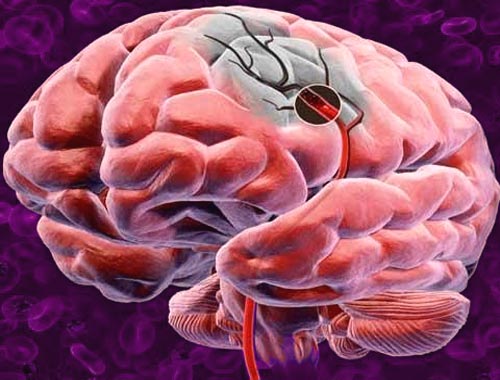Stroke, Ischemic Stroke

Published: 18 Jun 2025
ICD9: 434.01 ICD10: I63.30 ICD11: 8B11
An ischemic stroke is a type of stroke that occurs when a blood vessel supplying blood to the brain is blocked.
This blockage deprives brain cells of oxygen and nutrients, leading to damage or death. "Ischemic" refers to a condition of inadequate blood supply.
Here's a breakdown of the key aspects:
![]() Stroke: A general term referring to damage to the brain caused by interruption of its blood supply.
Stroke: A general term referring to damage to the brain caused by interruption of its blood supply.
![]() Ischemic: Means "deficient in blood supply." The term highlights the underlying mechanism: a lack of blood flow.
Ischemic: Means "deficient in blood supply." The term highlights the underlying mechanism: a lack of blood flow.
![]() Mechanism: The most common cause of ischemic stroke is a blood clot that blocks a brain artery. These clots can form locally (thrombosis) or travel from elsewhere in the body (embolism).
Mechanism: The most common cause of ischemic stroke is a blood clot that blocks a brain artery. These clots can form locally (thrombosis) or travel from elsewhere in the body (embolism).
![]() Consequences: Brain cells are highly sensitive to oxygen deprivation. Without sufficient blood flow, these cells begin to die within minutes, potentially leading to permanent brain damage and neurological deficits.
Consequences: Brain cells are highly sensitive to oxygen deprivation. Without sufficient blood flow, these cells begin to die within minutes, potentially leading to permanent brain damage and neurological deficits.
In simpler terms: Imagine a pipe carrying water (blood) to a plant (the brain). An ischemic stroke is like a blockage in that pipe. The plant doesn't get enough water and starts to wither and die.
Key Features:
![]() Most Common Type: Ischemic strokes are the most common type of stroke, accounting for around 87% of all stroke cases.
Most Common Type: Ischemic strokes are the most common type of stroke, accounting for around 87% of all stroke cases.
![]() Symptoms: Symptoms can vary widely depending on the location and extent of the brain damage. Common symptoms include:
Symptoms: Symptoms can vary widely depending on the location and extent of the brain damage. Common symptoms include:![]()

![]() Sudden numbness or weakness of the face, arm, or leg, especially on one side of the body.
Sudden numbness or weakness of the face, arm, or leg, especially on one side of the body.![]()

![]() Sudden trouble speaking or understanding speech.
Sudden trouble speaking or understanding speech.![]()

![]() Sudden trouble seeing in one or both eyes.
Sudden trouble seeing in one or both eyes.![]()

![]() Sudden dizziness, loss of balance, or coordination.
Sudden dizziness, loss of balance, or coordination.![]()

![]() Sudden severe headache with no known cause.
Sudden severe headache with no known cause.
![]() Treatment: Treatment for ischemic stroke focuses on restoring blood flow to the brain as quickly as possible. This can be achieved through:
Treatment: Treatment for ischemic stroke focuses on restoring blood flow to the brain as quickly as possible. This can be achieved through:![]()

![]() Thrombolytic drugs (tPA): Medications that dissolve blood clots. These are most effective when administered within a few hours of symptom onset (typically within 4.5 hours).
Thrombolytic drugs (tPA): Medications that dissolve blood clots. These are most effective when administered within a few hours of symptom onset (typically within 4.5 hours).![]()

![]() Mechanical thrombectomy: A procedure where a doctor uses a device to physically remove the clot from the blocked artery. This is usually considered for larger clots in major brain arteries and can be performed up to 24 hours after symptom onset in certain cases.
Mechanical thrombectomy: A procedure where a doctor uses a device to physically remove the clot from the blocked artery. This is usually considered for larger clots in major brain arteries and can be performed up to 24 hours after symptom onset in certain cases.![]()

![]() Supportive care: Managing blood pressure, oxygen levels, and other vital functions to optimize brain recovery.
Supportive care: Managing blood pressure, oxygen levels, and other vital functions to optimize brain recovery.
![]() Risk Factors: Many factors can increase the risk of ischemic stroke, including:
Risk Factors: Many factors can increase the risk of ischemic stroke, including:![]()

![]() High blood pressure
High blood pressure![]()

![]() High cholesterol
High cholesterol![]()

![]() Heart disease (especially atrial fibrillation)
Heart disease (especially atrial fibrillation)![]()

![]() Diabetes
Diabetes![]()

![]() Smoking
Smoking![]()

![]() Obesity
Obesity![]()

![]() Family history of stroke
Family history of stroke![]()

![]() Age
Age
Importance of Timely Treatment: "Time is brain" is a critical concept in stroke care. The sooner treatment is initiated, the better the chances of minimizing brain damage and improving long-term outcomes. Therefore, recognizing stroke symptoms and seeking immediate medical attention is crucial.